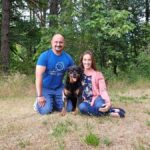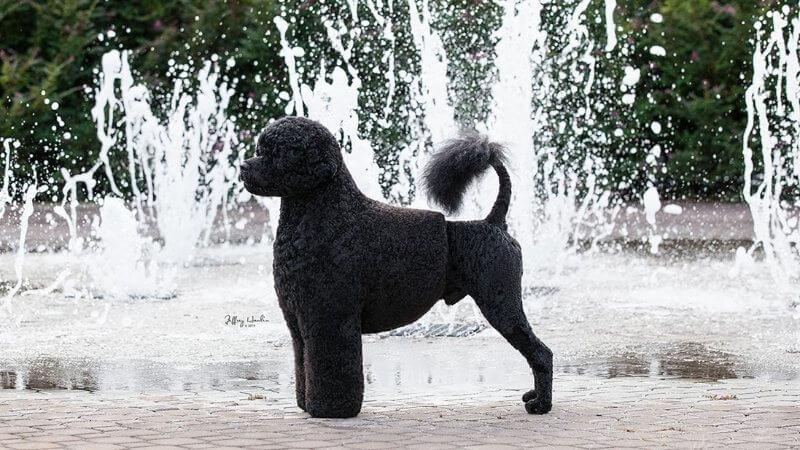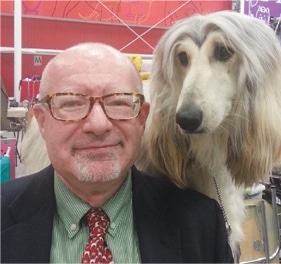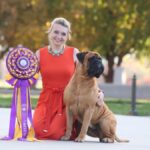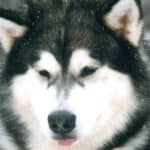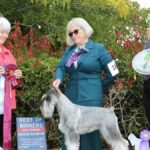Interview With Milan Lint, Breeder of Pouch Cove Kennels, by Allan Reznik
Where did you grow up? Do you come from a doggy family? And if not, how did the interest in breeding and showing dogs begin?
Milan Lint: I grew up in rural Ohio and throughout my childhood participated in 4-H, competitively exhibiting ponies and horses. My parents were supportive, patient with me and my siblings having all sorts of pets and farm animals. At age 16, I purchased my first purebred dog, a less-than-stellar but very sweet male Newfoundland that I decided must be shown in the local puppy match. Given the quality of the dog (despite my certainty that he was the most handsome of Newfoundlands) this made for a tough beginning in the show ring. That said, the first-place ribbon (in a class of one) had me hooked.
Who were your mentors in the sport? How did your friendship/partnership with Peggy and David Helming of Pouch Cove fame begin?
Milan Lint: I attended my first Newfoundland National Specialty in September 1979, held in Ann Arbor, Michigan. That was an exciting adventure for me, as it was where I first met Peggy and David, as well as Janet and Alan Levine and Betty McDonnell. Nearly 40 years later I remember that National Specialty like it was yesterday. The show was judged by Esther Mueller, who awarded BOB to Ch. Kilyka’s Black Bart, bred by Betty and presented by Gerlinde Hockla. As handsome as Bart was, I was especially taken with the BOS bitch owned and handled by the Levines, Ch. Ferryland’s Abby of Newton Ark, and the outstanding AOM dog owned and handled by the Helmings, Ch. Pouch Cove Gref of Newton Ark.
Much to my surprise and delight, Abby and Gref were both sired by the top producer Ch. Kuhaia’s Rego, and believe me, it wasn’t long before I had a Rego daughter and granddaughter at my home in Ohio! Those girls, by Rego and out of Pouch Cove and Newton Ark bitches, were the start of the Newfoundland program. Over the next few years I did limited breedings, producing quality dogs with some success in the show ring.
What prompted your involvement in Portuguese Water Dogs?
Milan Lint: In 1984 I attend the AKC Centennial show held in Philadelphia and had the opportunity to see Bill Trainor pilot the imported brown PWD Charlie De Alvalade to a group placement. I was intrigued by the breed, and once I began my university graduate studies I became increasingly interested in PWDs due to living space constraints that would not accommodate the Newfs.
I acquired my first Portuguese Water Dog bitch in 1988, followed by a high-quality girl that completed her championship easily and ultimately produced three litters for us. David and Peggy acquired their first PWD from me, and that worked out especially well as I had completed my graduate studies and relocated to New York City, providing the opportunity to work closely together on the PWD breeding and show program.
The Pouch Cove dogs are known and admired around the world. Tell us about that, and the breeding philosophies you adhere to.
Milan Lint: Peg and I have bred approximately 75 PWD AKC conformation champions and finished another ten or so stud fee puppies, including multiple top-rated, Best in Show and Working Group winners. To me, the most important show of the year is the PWDCA National Specialty, and we are particularly proud of Pouch Cove’s results as reflected by winning three times BOB, four times BOS, five times WD/WB, and multiple wins in Puppy and Veteran Sweepstakes as well as Brood Bitch and Stud Dog.
We have also owned the Number one PWD over five separate years, represented recently by the father and son Matisse (sired by Ch. Pouch Cove Caribe) and Preston, expertly presented throughout their careers by Michael and Michelle Scott—who are a critical component of our show ring success. With 238 all-breed Best in Show wins to his credit, Matisse is the top-winning male show dog in US history, a two-time National Specialty winner, a three-time Westminster Working Group winner, and Best in Show winner at the 2013 AKC/ Eukanuba Invitational. Importantly, not only did Matisse win BOB at the 2014 National Specialty, he was also the sire of the Winners Dog, Winners Bitch, Reserve Winners Dog, Reserve Winners Bitch and Best Puppy in Show!
Peg and I feel that our approach to producing healthy, happy and handsome PWDs has worked to date. The PWD parent club in the US has been extremely active regarding health issues and related testing, and we have taken full advantage in utilizing identified gene markers which has been a plus in improving the chances of producing extremely healthy dogs. That said, it is a real balance, as our breedings consist of much more than mixing one pile of health certificates with another. For us, in addition to the health clearances, the potential parents must also have the structure, carriage, demeanor, overall breed type and beauty that we prefer to admire and interact with each day. Making all of that come to fruition isn’t easy, but we keep on trying and hopefully succeeding, despite occasional setbacks.
Please comment on your breed’s present condition and what trends might bear watching.
Milan Lint: Relative to the 1980s (when I first entered the breed), the PWDs of today are more sound in temperament and with less variation in breed type. Simply put, we have pulled in the extremes where the current population of PWDs has a more definitive look. In my estimation those improvements have in no way negatively impacted the breed’s working ability.
Regarding trends, we have been particularly focused on overall proportion and balance, as the breed was tending toward lower and longer—characteristics that Peg and I find less appealing, and critically, are not in keeping with the breed standard. Our boys have helped in this regard, where the length of leg to length of back ratio and the resulting carriage across the breed is generally more appropriate and to
our liking.
You keep a few Affenpinschers at your residence in New York City. Are all your large dogs housed at Pouch Cove? Tell us about the facilities and how the dogs are maintained.
Milan Lint: Mitch and I have three monkeys (Frieda, Berta and Greta) with us in the city, while Fiona remains with Ernesto Lara. We have a country home in Bucks County, Pennsylvania, and it is set up for the PWDs, and as you mention, Peg and Dave also have PWDs at their place in Flemington, New Jersey, serving as exercise buddies for the Newfs. Additionally, Michael and Michelle typically have at least one of our PWDs and as you might imagine, that is a tightly run operation with fantastic facilities matched with the best of care and conditioning.
Regarding Pouch Cove, if you ever have the chance to visit Dave and Peg at their home be certain to take advantage of it. The combination of the spectacular property, the quality and care of the dogs, and the history and knowledge of the hosts is unique. Simply put, better mentors and friends do not exist, and I could go on and on about Peg and Dave’s attributes, accomplishments and contributions. That said, their success in purebred dogs and their stature in the community are more than evident.
Now with your campaigning of the Old English Sheepdog, Elsa, after Matisse and Fiona, did you make a conscious decision to begin backing worthy show dogs of other breeds? What went into this decision?
Milan Lint: There is less to the story than what one might imagine. Simply put, we breed, own and exhibit PWDs, and with Peg and Dave’s guidance, Michael and Michelle’s presentation skills, and my partner Mitch’s patience and financial indulgence, PWDs are my primary focus.
Mitch and I have owned Affens for many years, and while we completed championships on several, we are not breeders. We have the Affens as they are a great source of entertainment, making us laugh each and every day. That said, when seeing Fiona as a puppy we knew she was something special, and we thought it would be fun to work with top-notch dog people such as Tina and Bill Truesdale, and Ernesto, on the two-year campaign that resulted in Fiona being the Number one Toy in 2017, and a two-time National Specialty winner.
Elsa the OES came about in a very different manner. We do not breed or own OES, yet we very much admire and trust Colton and Heather, who had exhibited PWDs for us in past years—and, as many of your readers will remember, Colton and Swagger, Michael and Matisse provided the fancy with some of the great competition and sportsmanship in dog show history.
As timing would have it, our young PWD special was not going to be quite ready for the big leagues in 2018, and I had by chance spotted Elsa in the breed ring at a show in 2017. While I am in no way an OES expert, it didn’t take a genius to recognize her as a great one. Ironically, Elsa lost the breed that day, instead taking BOS, yet I was undeterred. At dinner that evening Heather and Colton discussed their hopes and dreams for the coming year. My sense was that, given their enthusiasm and confidence, a financial boost would enable Elsa and Heather to get on the road, making terrific things happen.That has been great to see and to be a small part of.
Going forward, I have no plans to present breeds other than PWDs and Affens, and even if I did, working with the “right team” is paramount for me. That is not surprising, once you are accustomed to the Helmings, Scotts, Truesdales, Johnsons and Ernesto!
You have been a longtime club officer in several organizations. Why is this important to you and how do you respond to breeder-exhibitors who do not belong to their local kennel club?
Milan Lint: I am currently the Treasurer for the Kennel Club of Philadelphia, the Vice President of the Morris & Essex Kennel Club, and, until recently, President of the Hatboro Dog Club. Longtime purebred dog enthusiasts typically enjoy well-planned events. That planning and execution requires time and effort, and I feel something of an obligation to do my part—as appropriately instilled in me over many years by David. Plus, I very much value the camaraderie associated with club membership
and participation.
I would, of course, like to see greater participation in local kennel clubs by breeders, exhibitors and, frankly, professional handlers who make their living from these events. To that point, I was both pleased and proud when Michael and Michelle became actively involved in the Westchester and Morris & Essex clubs. Great events don’t just happen—it instead takes the time, effort and energy of many.
The sport has changed greatly since you began as a breeder-exhibitor. What are your thoughts on the state of the fancy and the declining number of breeders? How do we encourage newcomers to join us, and remain in the sport?
Milan Lint: On this topic I may differ from many others in the sport. While I have a healthy respect for the past and very much enjoy discussing breeding programs and dogs of historical significance, my focus is much more on today and tomorrow. Despite what many dog people profess, “the good old days” are too often remembered as much better than what they really were. Relatedly, there is no greater turn-off to a newcomer than suggesting that our better days are behind us rather than ahead of us. For one, I don’t believe it. And even if I did, it is hardly the pitch I would use in getting others involved in purebred dogs.
All in all, I am buoyant about the future given tremendous progress in overall education, advancements in dog health, gene markers, sophisticated breeding practices and greater geographic access to alternative bloodlines. Simply put, we know so much more about dogs of interest—not only the phenotype, but the detailed underlying genetic map. And for those breeds where markers are not yet available—get moving! While my fellow PWD enthusiasts can be highly (and sometimes overly) passionate regarding these issues, our collective efforts have made a tremendous and positive difference in overall breed health.
Regarding number of breeders, we are indeed increasingly dependent on smaller-scale programs and that isn’t changing. It is therefore incumbent on me to learn about, visit and assess puppies from multiple breeders vs. one larger facility. We are doing our best to make that adjustment, as it is highly unlikely that we will experience large scale programs—especially in a breed such as PWDs that don’t do well in those settings.
Finally, tell us a little about Milan Lint outside of dogs… your profession, your hobbies.
Milan Lint: As previously mentioned, Mitch and I have lived in New York City for 25 years, though we are originally from Ohio, and are both graduates of the Ohio State University. Mitch is a longtime (20-year) partner at Ernst & Young, leading a large business that requires global travel. I am a Managing Director at BlackRock Investments and will shortly celebrate my 22-year anniversary. We have been fortunate both personally and professionally, perpetuating the addiction to purebred dogs, vintage autos, and extensive personal travel. That said, our favorite moments are invariably with friends, Affens and PWDs in beautiful Bucks County.
